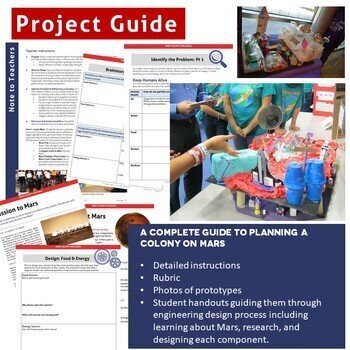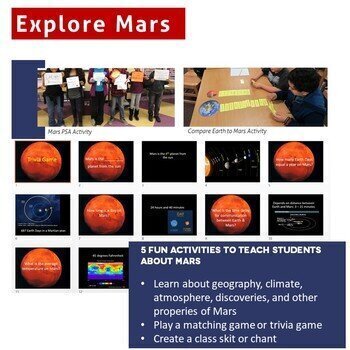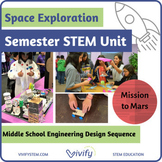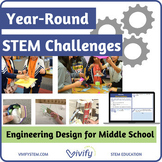Design a Mars Habitat STEM / STEAM Project Guide
- Zip
What educators are saying
Products in this Bundle (4)
Also included in
- Need a semester-long STEM unit? This Mission to Mars bundle includes engineering design challenges building up to a capstone project of building a habitat on Mars! Lesson Overview Transform your classroom into a team of astronauts on a Mission to Mars! This STEM curriculum begins with Stage 1 team cPrice $67.00Original Price $83.75Save $16.75
- Space STEM Starter Challenges GROWING Bundle: Upper Elementary & Middle School STEMLaunch your students into STEM with these space-themed STEM challenges that incorporate the engineering design process. This mega bundle includes engaging STEM activities for space activities and design challengesPrice $226.72Original Price $283.40Save $56.68
- Are you in need of year-round STEM activities? This growing bundle includes our most popular STEM lessons and engineering design challenges for middle school grades! Click here for more guidance on planning out a STEM class including a scope and sequence and example STEM curriculum map. Includes a SPrice $388.52Original Price $485.65Save $97.13
- Are you in need of year-round STEM activities? This growing bundle includes ALL Vivify K-12 STEM lessons from team challenges, engineering design, semester-long STEM units, research projects, and more! Purchase everything for 20% off individual products! Here is a sample of what is included: Stage 1Price $990.24Original Price $1237.80Save $247.56
Description
Design a habitat on Mars with our STEM project guide!
Take your STEM or STEAM classroom or program to the next level with this in-depth engineering design STEM challenge. Students will apply scientific concepts, math skills, critical thinking, research, and engineering design to plan a long term habitat on Mars. This creative and in-depth project is a great activity for your classroom or afterschool program! Watch the video and learn more about this project here.
Designing a Mars Colony is a real multidisciplinary project. Students will need to consider questions like: How will colonists get food? What is the Martian environment like? Will our colony have a government? How do we prevent boredom?
Mars Colony STEM Challenge Overview
Students learn about current efforts to colonize Mars and the harsh environment of this barren world. Students research and brainstorm engineering and mental health design solutions to keep colonists alive, healthy, and happy. The final colony design is put to the test with various scenarios. Educators may take this project a step further by providing students materials to build the final colony design and present to judges.
As a student-driven assignment, the purpose of the teacher is to act as a facilitator. You will provide the structure to the project, but students will take an active role in research, design, and building. This product is based on a 5 week long engineering design project where student teams research and develop prototypes for a Mars Colony. Prototypes are built from recycled materials and presented to STEM professionals for judging. The depth of this project is dependent on the available time frame and classroom needs. The product includes instructions for prototype building, but this component is completely optional.
Product 1: Explore Mars
Teach students all about Mars through 5 interactive games and activities! These games have students moving, creating, and learning basic facts about Mars including information on temperature, gravity, geography, atmosphere, and location. Activities require minimal supplies such as paper and a projector.
Product 2: STEM Project Guide
This complete project guide take students through the engineering design process to think about, research, design, and build a colony on Mars! Student handouts include reflection on society on Earth, learning about Mars, research, brainstorming solutions, designing colony, testing colony against scenarios, and final design layout. Includes video resource links for instructors. Updated with digital STEM journal for distance learning.
Product 3: Mission to Mars Planning Game
Students work in teams to complete the ultimate project-based learning STEM experience: planning a long-term settlement on Mars! These activities can be used as a companion to Mars Colony STEM Project Guide. This Mission to Mars Planning Game product dives deeper into possible colony solutions, adds an interactive and game-like planning tool, and is especially useful for students that need more guidance, ideas for design solutions, or have limited internet access.
Through game cards, students are introduced to real NASA technologies such as hydroponics, solar tents, MOXIE oxygen generator, and more! Students also learn about exciting current events in space exploration including the recent NASA Insight landing probe that reached the surface of Mars. As students read each game card, they debate the pros and cons of real technologies to support their own mission to Mars while staying withing budget and power limits.
Below are the different systems that teams will explore:
- Food
- Energy
- Water
- Air
- Communication
- Science Experiments
- Rovers
- Eating areas
- Hygiene
- Exercise
- Sleeping
- Entertainment
Looking for more STEM lessons? Our team of engineers and educators is dedicated to developing low-prep and high-quality STEM activities for any classroom! Click below to learn more:
- Vivify's Scope & Sequence + Standards Alignment
- Vivify's Resource Guide
- Learn about the 3 Stages of STEM
- Vivify STEM Membership
Customer Tips:
• Click the Green ★ to follow our store and get notifications of new products and freebies
• Leave feedback to receive TpT credit for use on future purchases
• Questions? Contact us in the Product Q&A section
♥ Connect With Us ♥
Email us: info@vivifystem.com









